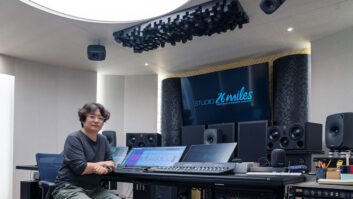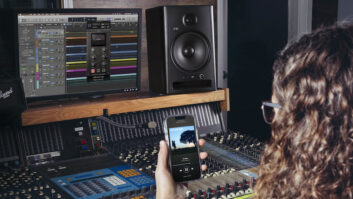Sometimes reverb is used to enhance reality-applied, as if with an artist’s paintbrush, to color, fatten, soften, smear or gel. Other times, reverb is used to emulate reality, to transport a performance from one place to another, making audio recorded in a sound booth, for instance, sound as if it were recorded in a concert hall. TC Electronic’s M3000 Studio Reverb Processor can handle the former, but its raison d’etre is to tackle the latter.
Reality is a complicated thing, and producing a reverb unit that will convince our brains that its algorithms reconstruct real spaces is a daunting, processor-hungry task. Mainly through a new algorithm, what TC Electronic calls VSS-3 (Virtual Space Simulator), the M3000 attempts to trick the listener into believing that the audio passing through its circuitry is actually traveling through a real space, with real walls, floors and ceilings.
The M3000 includes delay, pitch shifting, EQ, expansion, compression, chorusing, flanging, phasing, de-essing and a tremolo/panner. But the heart and soul of the M3000 are its elegant 24-bit reverbs, most notably those based on VSS-3. While the M3000 includes reverb algorithms from other TC Electronic products, such as the “C.O.R.E.” algorithm from the M2000 and the “REV3” algorithm from the M5000, the VSS-3 algorithm represents the company’s most ambitious, complex and flexible to date.
VSS-3 organizes reverb into a series of early reflections followed by a tail. Because the early reflections define a room’s “personality,” VSS-3 patches include between 40 and 100 early reflections. And because a high-quality tail is necessary to sustain a credible illusion, the designers labored to ensure that the .01 to 20 seconds allotted for VSS-3 tails maintain high fidelity throughout their decay.
ROBUST PALETTE OF OPTIONSBoth the early reflections and the tail can be independently modified via numerous parameters. For instance, the VSS-3 algorithm includes flexible filters that can make rooms seem darker, brighter, softer, etc. Filters can also be applied to diminish frequencies in the reverb that compete with the source audio. A robust palette of gating and modulation options provides further ways to alter the effect. And the duration between the dry sound and the onset of early reflections, as well as the duration between the early reflections and the tail, can be independently changed.
The M3000’s dual-processing architecture makes it powerful and easy to use. With two processing engines, it is essentially two machines in one. While a Dual Mono mode splits the unit into two separate mono processors, there are a number of routing options that permit the processors, each of which can output a stereo pair, to be combined in a variety of ways.
For example, in Serial mode, the outputs from one engine are sent to the inputs of the other. This setting is particularly useful for compressing a drum track or de-essing a vocal in one engine before sending it to the other for reverb. Parallel, Dual Input and Linked modes can be used for combinations of stereo effects, and a Preset Glide mode allows a current effect to crossfade smoothly into a new preset.
One of the M3000’s most creative effects is called Dynamic Morphing. Despite a name that sounds like an exciting new opiate derivative, Dynamic Morphing actually links the level at the main input to the levels of each engine’s output, switching between them with respect to a user-defined threshold. Depending on the loudness of the source audio, the M3000 will output more or less of the effect generated by either engine. This can be used, for instance, during a song in which loud, belted notes yield one effect that gracefully changes into another effect as the singer simmers down.
SIMPLE INTERFACEControlling the M3000 is a breeze, thanks to a simple interface that belies the power and flexibility under the hood. Buttons, arranged into columns labeled Setup, Engine 1, Engine 2, Combined 1+2, Snapshots and Control, dominate the anodized aluminum face. A slot for a PCMCIA card, an LCD screen and an adjust knob surround the columns. Pressing a button retrieves the associated menus, which can be navigated by using cursor keys in the control column in tandem with the adjust knob. A Tap key for controlling the speed of delays, decays, tremolos, phasers, flangers and chorusing, and an on/off button with a protective delay, complete the front controls.
Much as I hate plodding through manuals, I usually have little choice. Not so with the M3000. I found that I could easily navigate and edit patches without consulting the preliminary manual that came with the unit.
Patches can be chosen through scrolling or with the help of the “Reverb Wizard.” With the Wizard, responding to queries yields a menu of suggested patches. Alternatively, pressing the Recall button in either engine’s (or the combination) column, scrolling through 250 single or 50 combined presets and pressing OK selects a patch. Another 250 single and 50 combination user-created (or future company-created) patches can be stored in internal RAM, which can be recalled from and stored on PCMCIA cards.
Patches can be edited through either a “User” mode (limited generalized variables) or an “Expert” mode (many specific variables). MIDI implementation is thorough, and includes a cool MIDI monitor screen that displays MIDI activity and related information.
Using the M3000 reminded me of the way in which I use samples of acoustic instruments. First I formed a mental “image” of a real room, and then I attempted to replicate its character and idiosyncrasies via the electronic surrogate. I experimented with a grand piano I had recorded dry, using patches called “Concert Piano” and “Piano Hall, First Row.” The reverb not only sounded gorgeous and subtle, but it also seemed to have an organic relationship with its audio source. Applying Stereo Large Hall to dry tracks of orchestral instruments, from double reeds to strings, also yielded excellent results.
LUSH AND DENSE STEREOWith pop-oriented material, it did not take long to discover that vocals love the M3000. One of my favorite setups involved sending vocals through a “40x40ft Studio” patch in one engine, and a Large Warm Hall patch in the other. With routing set to parallel, the M3000 mixed the stereo output of each engine into a wonderfully lush and dense master stereo out.
On one fantasy-indulging occasion, with curtains drawn and door shut, I used the Vocal Deep Male patch on myself to turn Take 6 into Take 7. Sometimes less is definitely more. I also had fun using the In the Clouds patch to transform carnivorous rock into vegan new age.
The back of the unit includes a generous array of connection options. Analog connections are made through balanced XLRs. Digital connections include AES/EBU (24-bit), S/PDIF (20-bit), Optical Toslink and ADAT. There are also ports for digital wordclock, MIDI In, Thru and Out, and External Control Input.
Because signals are present on all outputs, as is the case with my Tascam DA-30 MkII DAT machine, the M3000 can be put to work as either a format converter, or an A/D or D/A converter. Another cool trick is to input two ADAT channels into the M3000, process them and output the result to two different ADAT channels without ever leaving the land of zeros and ones.
The M3000 includes many other useful digital bells and whistles. For instance, a digital gain section, separate from the analog input gain, can add up to +6 dB for increasing the signal of lightly-recorded digital material prior to processing. Dithering (type HP-TDF) can also be added from 8-bit through 22-bit resolution to off. Finally, while the M3000 can recognize word clock from 32 kHz to 48 kHz, it can also use its own internal clock, making it an available master clock in a digital environment.
EXEMPLARY TECHNICAL SUPPORTShould you need it, by the way, I have found TC Electronic’s tech help to be exemplary. In my experience-and I purposely did not reveal that I was reviewing the product-TC Electronic’s technicians have always been personable, responsive and knowledgeable.
Sure, I could nit-pick. A blinking light that engages on this and other TC Electronic devices after they are turned off, is, in my opinion, more distracting than helpful. And patches sound like they were named in an afternoon. For instance, there’s Real Room, not to be confused with A Real Room, and another one, if you can believe it, called Kinky Chinks. However, these are criticisms of presentation, not operation.
Regarding operation, while the M3000 may not represent the final step in digital reverb’s march up the mountain to audio perfection, it represents a legitimate step closer to the summit. For sheer variety of effects, TC Electronic’s Fireworx or Lexicon’s PCM 81 may be a better bet. But the M3000 is among the highest-quality reverbs available today and, at a reasonable $2,499, deserves a serious look.
TC Electronic, 790-H Hampshire Road, Westlake Village, CA 91361; 805/ 373-1828; fax 805/379-2648.







